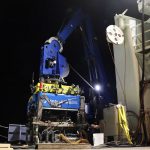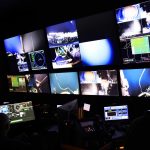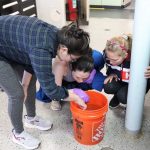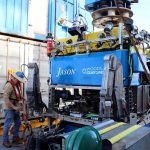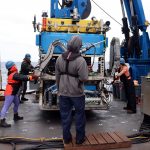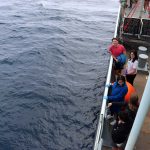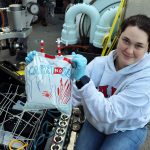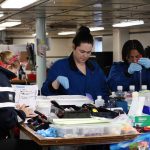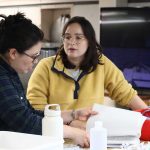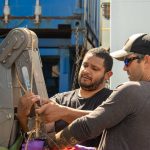Mission accomplished!
The numbers and teamwork that made PROTATAX23 a success
The dives are over, samples are stowed in freezers, Jason is strapped to the deck, and R/V Thomas Thompson is steaming towards port in Newport, Oregon. Just like that, PROTATAX23 is wrapping up. In the ship's main lab, the science team is starting to disassemble their temporary workspace.
The cruise was a success-with more dives than anticipated, working instruments, and a team that weathered around-the-clock watches and learned new roles with grace. Here are some of the numbers that demonstrate that success.
PROTATAX 23, by the numbers
- 8 dives
- 19 hydrothermal vent sites visited
- 144 total samples taken with Jason
- 1,539.7 meters deepest sample taken
- 25 samples taken from vent fluids over 220°C
- 320°C hottest sample taken
- 1,154 liters vent fluid and seawater collected
- 132 liters filtered on the seafloor by SUPR
- 174 liters vent fluid collected by the Universal Fluid Obtainer and SUPR
- 16 shipboard grazing experiments
- 18 in situ experiments performed by the miniSID
- 109 times people have requested for their on-ship data limit to be reset
- 2 pounds M&Ms consumed by the science party (plain, dark, peanut, and peanut butter, if you must know)
About those samples
"Our biggest goal was to deploy the miniSID successfully three times and do three shipboard grazing experiments for comparison," said Chief Scientist and WHOI scientist Julie Huber. "We have exceeded that several times over."
"It went so well," said co-PI and Texas A&M professor Sarah Hu. "We have so many water samples that we are using up all the supplies we brought with us."
"Our instruments working was a huge success," added co-PI and WHOI scientist Maria Pachiadaki. "And we learned a lot." Pachiadaki has deployed miniSID in the midwater, but this was the first time it was used for in situ grazing experiments at the seafloor.
The majority of the water samples are going back to Huber's lab at WHOI, where Hu, along with Texas A&M graduate students Alexis Adams and Kayla Nedd will start processing this summer, and will continue to work on the data from this expedition for years to come.
Learning to roll with science at sea
The science party came from different institutions, experience levels, and points in their careers, and formed a cadence of work at sea. For the Hu Lab, which assembled an on-ship lab from graduate students and postdoctoral fellows, it worked seamlessly.
"They had to learn how to prepare for the fluid coming up and adapt to changes at the last minute," said Hu. "Everyone dived right in. They also made sure their teammates were eating, sleeping, and tracked each other's seasickness. They have honestly all taken ownership of their work, and it's been great."
In addition to assembling a team to accomplish the main science goals, Huber invited scientists and students who also study the vents at Axial Seamount to join the expedition to capture high-temperature vent fluids for geochemical sampling, cultivate heat-loving bacteria and archaea from venting fluids, collect sulfide chimneys for spectroscopic analysis, run a CTD program, and pick up previously deployed microbe bait traps.
"It speaks to Axial Seamount being such a well-studied, community effort," said Hu, noting how well these different science goals worked in parallel. "We know who needs something here. We picked up other group's temperature loggers when we were at certain vents and if we had deployed something this cruise, we know someone else would be able to pick it up for us."
"I am so excited that after years of anticipation and COVID delays, we finally pulled this expedition off successfully," said Huber. "I have been studying Axial since I was a first-year graduate student and every trip is unique. Everyone here-from the thoughtful ship's crew to the amazing Jason Team to our wonderful science party-helped accomplish the science goals at Axial Seamount that will deepen our understanding of this fascinating corner of our blue planet."
- Hannah Piecuch
This NDSF blog series will follow the PROTATAX23 expedition to Axial Seamount, covering the science and scientists at sea, and the ROV Jason operations that make it possible. PROTATAX23 is funded by the National Science Foundation (NSF OCE Award #1947776).


